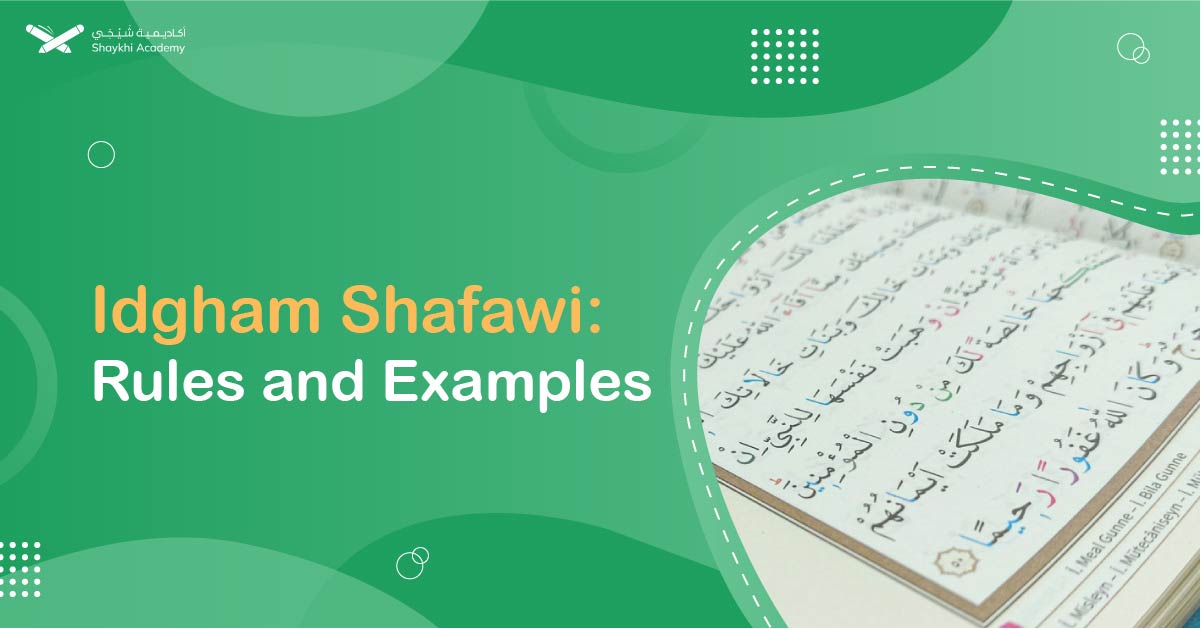Idgham Shafawi, a key concept in Tajweed, involves the merging of two Meem letters, creating a seamless, prolonged sound. This rule, applied when a Meem Sakina (مْ) is followed by another Meem, enhances the clarity, beauty, and correctness of Quranic recitation.
Mastering Idgham Shafawi ensures precise pronunciation and a deeper spiritual connection with the Qur’an. Comprehensive courses, like those offered by Shaykhi Academy, can help learners achieve accurate and beautiful recitation.
For those seeking to elevate their Qur’an recitation, mastering the intricacies of Tajweed (the rules of Qur’anic pronunciation) is essential. One crucial concept is Idgham Shafawi, a fascinating phenomenon where two letters merge seamlessly to create a richer and smoother sound.
This article delves into Idgham Shafawi, exploring its definition, rulings, and types, all illustrated with examples from the Qur’an for practical application. By understanding this concept, you’ll gain the tools to recite the Qur’an with proper articulation and enhanced beauty.
Definition of Idgham Shafawi
Idgham Shafawi (إدغام شفوي) is a specific type of assimilation that occurs when the letter Meem Sakina (مْ) is followed by another Meem (م). The term “Shafawi” is derived from “Shafah” (شفه), meaning “lip” in Arabic, indicating that this rule involves the lips. In this context, “Idgham” refers to the merging or blending of two sounds.
What is the Idgham Shafawi Rule?
In Idgham Shafawi, when a Meem Sakina (مْ) appears, followed directly by another Meem, the rule merges the first Meem into the second, creating a single, lengthened Meem sound. This merger involves a slight nasal sound and the complete joining of the two Meems.
The Importance of Idgham Shafawi in The Quran’s Recitation
Idgham Shafawi, like other rules of Tajweed, plays a crucial role in ensuring the clarity, beauty, and correctness of Quranic recitation. Proper application of Idgham Shafawi:
- Maintains the integrity of the Quranic text.
- Enhances the listener’s experience, making the recitation more melodious and flowing.
- Prevents misunderstanding that might arise from incorrect pronunciation.
- To deepen your understanding and master the rules of Tajweed, including Idgham Shafawi, consider enrolling in a specialized course. Shaykhi Academy offers comprehensive Tajweed courses taught by experienced native tutors.
In addition to the aesthetic beauty it brings to Quranic recitation, it’s paramount not to forget that the rules of Tajweed carry profound religious and spiritual significance. Idgham Shafawi is one of these rules that enhances the clarity and meaning of the Quranic text.
By adhering to Tajweed rules, the reciter gains a deeper understanding of the Quranic verses and can articulate them with precision. Therefore, anyone seeking to engage with the Quran should devote effort to learning and applying these rules accurately and attentively.
The Phonetics of Idgham Shafawi:
It’s essential not to overlook the phonetic aspect when discussing Idgham Shafawi. This rule involves the merging of two sound-producing letters, creating a single, prolonged sound. In the case of Idgham Shafawi, the merging typically occurs between the nasal cavity and the mouth, where the Meem Sakinah or Tanween is assimilated into the following Meem or Noon, resulting in a smooth transition between the two sounds. Understanding the phonetic mechanics behind Idgham Shafawi adds depth to one’s recitation and fosters a more profound connection with the Quranic text.
Types of Idgham Shafawi
There is only one type of Idgham Shafawi which was the merging of two Meems. However, it can be seen as part of a broader category of Idgham rules in Tajweed, where similar assimilation occurs with other letters under different conditions.
Examples – Idgham Shafawi:
The Idgham Shafawi rule must be applied consistently during Quranic recitation to maintain the correct pronunciation and rhythm. Failure to do so can lead to errors that may alter the meaning of the recited verses. Therefore, mastering this rule is crucial for anyone seeking to improve their Quranic recitation skills.
Understanding Idgham Shafawi is best achieved through practical examples from the Quran.
1. ﴿يُرْسِلِ السَّمَاء عَلَيْكُم مِّدْرَاراً﴾ (نوح 11)
o Transliteration: “Yursil assamaa’ ‘alaykum midraaran”
o Idgham Shafawi: Here, the merging of the Meems occurs in “alaykum midraaran” as the Meem Sakina in “alaykum” merges with the following Meem in “midraaran.”
2. ﴿أَمْ تَسْأَلُهُمْ أَجْراً فَهُم مِّن مَّغْرَمٍ مُّثْقَلُونَ﴾ (القلم 46)
o Transliteration:”Am tas’aluhum ajran fahum min maghramin muthqaloon”
o Idgham Shafawi: In this verse from Surah Al-Qalam (46), we observe the occurrence of Idgham Shafawi in the phrase “فَهُم مِّن مَّغْرَمٍ”. Idgham Shafawi involves the merging of two Meems: the first being the Meem Sakinah (مْ) in “مِّن” and the second being the Meem (م) in “مَّغْرَمٍ”.
The first strengthened Meem (مِّن) falls under the category of Idgham of the Noon Sakinah into a Meem, where the Noon Sakinah is assimilated into the following Meem.
As for the second strengthened Meem (مَّغْرَمٍ مُّثْقَلُونَ), it involves Idgham of the Tanween into a Meem, where the Tanween is assimilated into the following Meem.
This verse beautifully exemplifies the application of Idgham Shafawi within the Quranic text, demonstrating the seamless blending of sounds to enhance the rhythm and flow of recitation.
Visual Explanations Idgham Shafawi Rule
| Condition | Description | Example |
| Idgham Shafawi | Occurs when Meem Sakina (مْ) is followed by another Meem (م) | ﴿إِنَّهَا عَلَيْهِم مُّؤْصَدَةٌ﴾ (الهمزة – 8) |
More Examples of Idgham Shafawi in Quran
| Surah | Ayah | Example | Explanation |
| Quraysh | 4 | ﴿الَّذِي أَطْعَمَهُم مِّن جُوعٍ﴾ | Merging of Meem Sakina in “أَطْعَمَهُم” with Meem in “مِّن” |
| Al-Mutaffifin | 4 | ﴿أَلَا يَظُنُّ أُولَئِكَ أَنَّهُم مَّبْعُوثُونَ﴾ | Merging of Meem Sakina in “أَنَّهُم” with Meem in “مَّبْعُوثُونَ” |
| Quraysh | 4 | ﴿وَآمَنَهُم مِّنْ خَوْفٍ﴾ | Merging of Meem Sakina in “وَآمَنَهُم” with Meem in “مِّن” |
| Al-Buruj | 20 | ﴿وَاللَّهُ مِن وَرَائِهِم مُّحِيطٌ﴾ | Merging of Meem Sakina in “وَرَائِهِم” with Meem in ” مُّحِيطٌ” |
Al-Mursalat | 20 | ﴿أَلَمْ نَخْلُقكُّم مِّن مَّاء مَّهِينٍ﴾ | Merging of Meem Sakina in “نَخْلُقكُّم” with Meem in “مِّن” |
| Nuh | 25 | ﴿فَلَمْ يَجِدُوا لَهُم مِّن دُونِ اللَّهِ أَنصَاراً﴾ | Merging of Meem Sakina in “لهُم ” with Meem in “مِّن” |
Nuh | 17 | ﴿وَاللَّهُ أَنبَتَكُم مِّنَ الْأَرْضِ نَبَاتاً﴾ | Merging of Meem Sakina in “أَنبَتَكُم” with Meem in “مِّن” |
| Al-Ma’arij | 27 | ﴿وَالَّذِينَ هُم مِّنْ عَذَابِ رَبِّهِم مُّشْفِقُونَ﴾ | Merging of Meem Sakina in “هُم” with Meem in “مِّن” And Merging of Meem Sakina in “ربهُم” with Meem in “مُّشْفِقُونَ” |
Learn Tajweed With Shaykhi’s Arabic Azhari Tutors
Mastering Idgham Shafawi is essential for any serious student of the Quran. It ensures that the recitation is performed correctly, preserving the meanings and beauty of the Quranic text. Shaykhi Academy offers comprehensive courses on Tajweed, including Idgham Shafawi, to help you achieve accurate and beautiful recitation.
Unlock the path to Quranic mastery with Shaykhi Academy! Our courses, taught by experienced native tutors, provide flexible and affordable learning opportunities for all levels. Book your free trial today and start your journey towards mastering the Quran.
For more information and to explore our range of courses, visit Shaykhi Academy.
Why Choose Shaykhi Academy?
- Connect with highly qualified native tutors.
- Flexible scheduling to suit your busy lifestyle.
- Affordable classes tailored for all levels.
- Accessible from anywhere around the globe.
Discover Our Range of Courses:
- Arabic Noorani Qaida: Lay a solid foundation for Quranic studies.
- Online Quran Classes for Kids: Engaging lessons for lifelong learning.
- Tajweed Rules for Kids: Learn to recite with confidence.
- Quran Hifz for Kids: Step-by-step guidance to memorize the Quran.
- Quran for Adults: Introduce yourself to Quran reading and Tajweed rules.
- Online Arabic Courses: Master the language of the Quran.
- Islamic Studies: A wide range of topics related to Islam, including theology, law, Quranic studies, Hadith.
Don’t Miss Out on Your Chance to Excel!
Whether you’re a beginner or seeking advanced knowledge, Shaykhi Academy can guide you! Book your free trial now and make Ramadan 2024 your Quranic turning point!

Conclusion:
Mastering Idgham Shafawi is crucial for precise Qur’anic recitation. This article explores its definition, rules, and practical applications. Idgham Shafawi occurs when the letter Meem (م) is followed by another Meem, merging them into a single, prolonged sound.
The rule dictates that when a Meem Sakina (مْ) appears before another Meem, the first Meem merges into the second, enhancing the recitation’s rhythm and flow. Practical examples from the Qur’an, such as in Surah Nuh (11) and Surah Al-Qalam (46), illustrate the importance of accurate pronunciation. Proper application ensures clarity and beauty in recitation, highlighting the significance of Tajweed rules for a deeper spiritual connection with the Qur’an.

















































